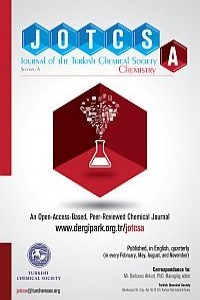FENİLALANİN’İN GEÇİŞ METAL İYONLARI TARAFINDAN OKSİDATİF BOZUNMASININ İNCELENMESİ
Bu çalısmanın amacı, bilinen en basit aromatik amino asit olan fenilalaninin, geçis metalleri tarafından bozunma mekanizmasının kuantum mekaniksel yöntemler ile incelenmesidir. Bütün temel haller ve geçis halleri M06-2X yoğunluk fonksiyoneli teorisi metodu ile optimize edilmistir. Aynı sınıfa ait diğer bir metod olan M06 ile de ek hesaplamalar yapılarak metodlar arası kıyaslamalar yapılmıstır.Yakın geçmiste ekmek mayası olan Saccharomyces cerevisiae’nin kobalt ve nikel gibi çesitli geçis metallerinin varlığında göstermis olduğu transkriptomik seviyedeki değisimlerin profili çıkartılmıstır [1, 2]. Bulunan sonuçlara göre, kobalta dayanıklı olan maya mutantları aromatik amino asitlerin seviyesini azaltma yoluna gitmekte ve Co3+ gibi geçis metallerinin aromatic amino asitler ile etkilesime girerek hücrede zararlı materyaller olusturabileceğini düsündürmektedir.Amino asitlerin in vitro ortamlarda bozunma tepkimeleri literatürde çok kez incelenmis olmasına rağmen, reaksiyon mekanizması ve reaksiyon sırasında olusan ara metabolitlerin neler oldukları açığa çıkmamıstır. Alkali ortamda diperiodatokuprat(III) veya sülfürik asit ortamında Mn3+ ve onun hidroksi formu (Mn(OH)2+) gibi oksitleyici ajanlar ile reaksiyonlar olusturulabilmistir [3, 4],ancak Co3+ ve fenilalanin amino asidi hiç çalısılmamıstır. Bu çalısmada, kobalt(III) iyonlarının aromatik amino asitlere karsı güçlü birer oksitleyici ajanolduğu sonucu gösterilmistir. Bu çalısma sonucunda zwitterionik fenil alaninin nötral pH’da gösterdiği çesitli bozunma tepkimeleri ile Co3+ iyonunun bu bozunma tepkimelerine olan etkisi açığa çıkmıstır. Fenilalanin amino asidinin bir Co3+ iyonu ile oksitlenmesi, fenilalaninin dekarboksilasyon ve deprotonasyon reaksiyonları göstermesine sebep olmaktadır. Aromatik halkanın varlığı redoks reaksiyonlarının olusumunu kolaylastırıcı bir etmendir. Đkinci bir Co3+ iyonunun reaksiyona katılıpoksidasyon tepkimesi verdiği sırada es zamanlı olarak gerçeklesen OH- iyonunun nükleofilik saldırısı fenil asetaldehit molekülü olusturmaktadır. Baska bir reaksiyon mekanizması, iki adet Co3+ iyonunun da tepkimeye katılması sonucunda açığa çıkartılmıstır ve bu mekanizma sonucunda fenilasetamid molekülü olusturmaktadır. Yapılan serbest enerji değisimi hesaplamalarına göre bu mekanizma ilkine göre daha yüksek bir aktivasyon enerjisine sahiptir. Periyodik cetvelde kobaltın yakın çevresinde bulunan Fe3+ ve Ni3+ gibi diğer geçis metal iyonlarının de fenilalanin amino asidi ile tepkimeleri de bu çalısmada incelenen konulardan birisidir. Elde edilen sonuçlara göre bu iki geçis metali yukarıda bahsedilen redoks tepkimelerini yapamamaktadır.
Anahtar Kelimeler:
-
THE INVESTIGATION OF OXIDATIVE DECOMPOSITION OF PHENYL ALANINE BY TRANSITION METAL IONS
The aim of this study is to comprehend the mechanism of the oxidative decomposition of phenylalanine (the simplest aromatic amino acid) by transition metals, in particular cobalt, using quantum mechanical tools. All the ground and transition state structures are optimized using the density functional method M06-2X. Additional calculations have been carried out using M06.Recently, a couple of works for profiling the transcriptomic data of the yeast Saccharomyces cerevisiae when exposed to transition metals, such as cobalt and nickel were done by Çakar and co-workers [1, 2]. According to their results, the cobalt-resistant mutants had a tendency to reduce the amount of aromatic amino acids, suggesting that Co3+, but not other metals, reacts specifically with aromatic amino acids, yielding harmful products.Although the in vitro decomposition of amino acids has been considered in numerous studies in the literature, the mechanism and intermediates formed during the reaction are not clear. The reactions use oxidizing agents such as diperiodatocuprate(III) in alkaline medium, or Mn3+ and its hydroxide form (Mn(OH)2+) in sulfuric acid medium [3, 4]. But the reaction of Co3+ withphenylalanine was not studied.In this study, it has been shown that cobalt (III) ions are powerful oxidizing agents against aromatic amino acids. Our study has revealed several pathways of the decomposition reaction of zwitterionic phenyl alanine at neutral pH and the effect of the Co3+ ion on the decomposition reaction.It was shown that the oxidation of phenylalanine by a Co3+ ion results in decarboxylation and deprotonation of phenylalanine. The presence of the aromatic ring facilitates the redox reaction. Then, oxidation by a second Co3+ in concert with the nucleophilic addition of an OH- ion leads to a pathway that yields phenyl acetaldehyde.A different pathway may proceed through oxidation by two more Co3+ ions and yield phenylacetamide. But this pathway has a higher activation free energy. Another possible decomposition pathway yielding phenylpyruvate also requires a considerably high reaction activation free energy.The reactions of Fe3+ and Ni3+ with phenylalanine have also been investigated. It has been found that these two transition metal ions are not suitable for the reactions mentioned above.
Keywords:
-,
___
- Küçükgöze, G., et al. FEMS Yeast Research 13(8): 731-746, (2013).
- Alkim, C., et al. Metallomics 5(8): 1043-1060, (2013).
- Hosamani, R. R., et al. Monatshefte für Chemie 141(10): 1069-1076, (2010).
- Kumara, M. N., et al. International Journal of Chemical Kinetics 43(11): 599-607, (2011).
- Başlangıç: 2014
- Yayıncı: Türkiye Kimya Derneği
Sayıdaki Diğer Makaleler
Niyazi Bulut, Jacek Klos, Octavio Roncero
Nihat KARAKUŞ, Dilara ÖZBAKIR IŞIN
HSP70 SAPERON PROTEINININ ATP HİDROLİZ MEKANİZMASININ İNCELENMESİ
Oğuzhan MARABA, Gizem DİNLER DOĞANAY, Bülent BALTA
Ca3Co4O9 SĐSTEMİNİN ELEKTRONİK KONFİGÜRASYONU İÇİN SİMETRİ FAKTÖRÜ
CavAb KANALINA KALSIYUM VE SODYUM İYONUNUN BAĞLANMA MEKANİZMASI
Turgut Baştuğ, Murat Çavuş, Serdar Kuyucak
ISI ŞOK PROTEİNİ Hsp70’İN MOLEKÜLER DİNAMİK SİMÜLASYONLARI İLE İNCELENMESİ
Bülent BALTA, Gizem DİNLER DOĞANAY
FORMIL KROMON SCHIFF BAZLARININ ANTİOKSİDAN AKTİVİTELERİNİN DFT ÇALISMASI
